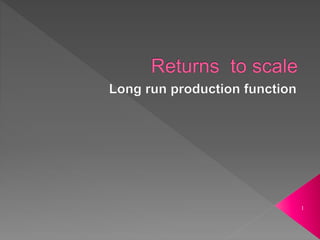Returns to scale
Isoquant is also called as equal product curve or production indifference curve or constant product curve. Isoquant indicates various combinations of two factors of production which give the same level of output per unit of time. Just as an indifference curve represents various combinations of two goods which give a consumer equal amount of satisfaction, an iso-product curve shows all possible combinations of two inputs physically capable of producing a given level of output. Since an iso-product curve represents those combinations which will result in the production of an equal quantity of output, the producer would be indifferent between them. This law was given by Alfred Marshall in his book principle of economics. It show particular pattern of change in output when some factor remain fixed. Production depend upon factors of production , if factors of production are good, production may increase and vice-versa. Production function show functional relationship between production and factors of production. It refers to manner of change in output cost by the increase in all the input simultaneously and in the same proportion. Returns refers to “change in physical output” Scale refers to “quantity of input employed” Change in scale means that all factors of production are increased or decreased in same proportion. The cost advantage that arises with increased output of a product. It arises because of the inverse relationship between the quantity produced and per-unit fixed cost. Profit refers to the excess of receipts from the sale of goods over the expenditure incurred on producing them. The amount received from the sale of goods is known as ‘revenue’ and the expenditure on production of such goods is termed as ‘cost’. The difference between revenue and cost is known as ‘profit’. For example, if a firm sells goods for Rs. 10 crores after incurring an expenditure of Rs. 7 crores, then profit will be Rs. 3 crores.

Mais conteúdo relacionado
Mais procurados (20)
Semelhante a Returns to scale
Semelhante a Returns to scale (20)
Mais de Yashika Parekh
Mais de Yashika Parekh (20)
Último
Último (20)
Returns to scale
- 1. 1
- 2. It refers to manner of change in output cost by the increase in all the input simultaneously and in the same proportion. Returns refers to “change in physical output” Scale refers to “quantity of input employed” Change in scale means that all factors of production are increased or decreased in same proportion. 2
- 3. Returns to scale may be: -increasing returns to scale -constant returns to scale -decreasing returns to scale 3
- 4. When percentage (%) increase in all factor inputs causes proportionately greater increase in output it is (IRS) It is also known as stage of decreasing cost This stage occurs due to economies of large scale production When a firm expands, increasing IRS obtained in beginning 4
- 5. If the amount of inputs are doubled and the output increases by more than double, it is said to be an increasing returns to scale. When there is an increase in the scale of production, it leads to lower average cost per unit produced as the firm enjoys economies of scale. 5
- 6. More division of labor Use of specialized machines 6
- 7. When percentage increase in all factor inputs causes equal proportionate increase in output It is known as “linear homogeneous production function” CRS operates when firm has achieved the point of maximum capacity So this stage occurs due to combine effect of economies and diseconomies of scale 7
- 8. If a firm doubles inputs, it doubles output. In case, it triples output. The constant scale of production has no effect on average cost per unit produced. 8
- 9. When percentage increase in all factor inputs causes proportionately less increase in output Generally there is a level after which output increases in a smaller proportion as compare to increase in the amount of factor inputs 9
- 10. DRS occurs, if firm keeps on increasing the inputs even after the stage of optimum capacity This stage also known as stage of increasing cost and occurs because of economies of large scale production 10
- 11. If a firm increases inputs by 100% but the output decreases by less than 100%, the firm is said to exhibit decreasing returns to scale. In case of decreasing returns to scale, the firm faces diseconomies of scale. The firm's scale of production leads to higher average cost per unit produced 11
- 12. Difficulty in coordination and management Technical diseconomies Limited availability of factors of production 12
- 13. 13
- 14. The figure shows that when a firm uses one unit of labour and one unit of capital, point a, it produces 1 unit of quantity as is shown on the q = 1 isoquant. When the firm doubles its outputs by using 2 units of labour and 2 units of capital, it produces more than double from q = 1 to q = 3. So the production function has increasing returns to scale in this range. Another output from quantity 3 to quantity 6. At the last doubling point c to point d, the production function has decreasing returns to scale. The doubling of output from 4 units of input, causes output to increase from 6 to 8 units increases of two units only. 14
- 15. THANK YOU 15
